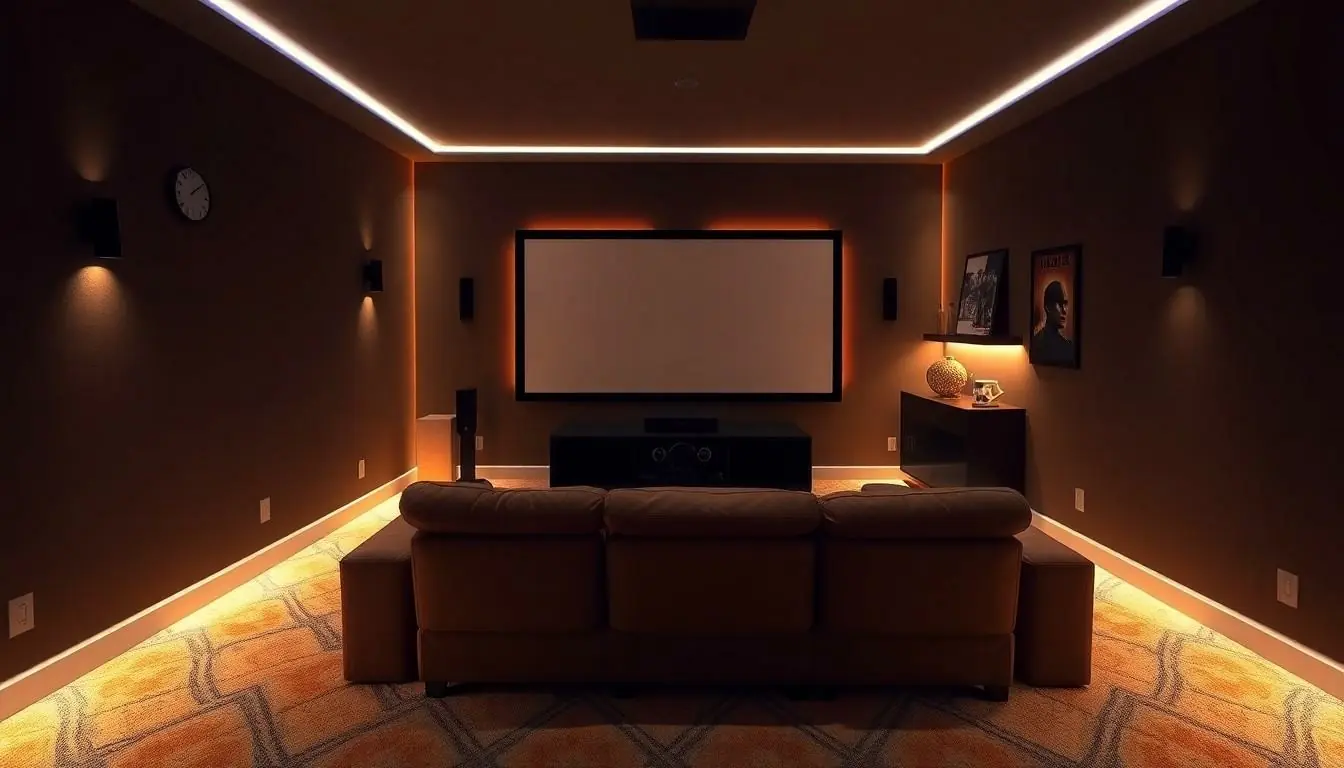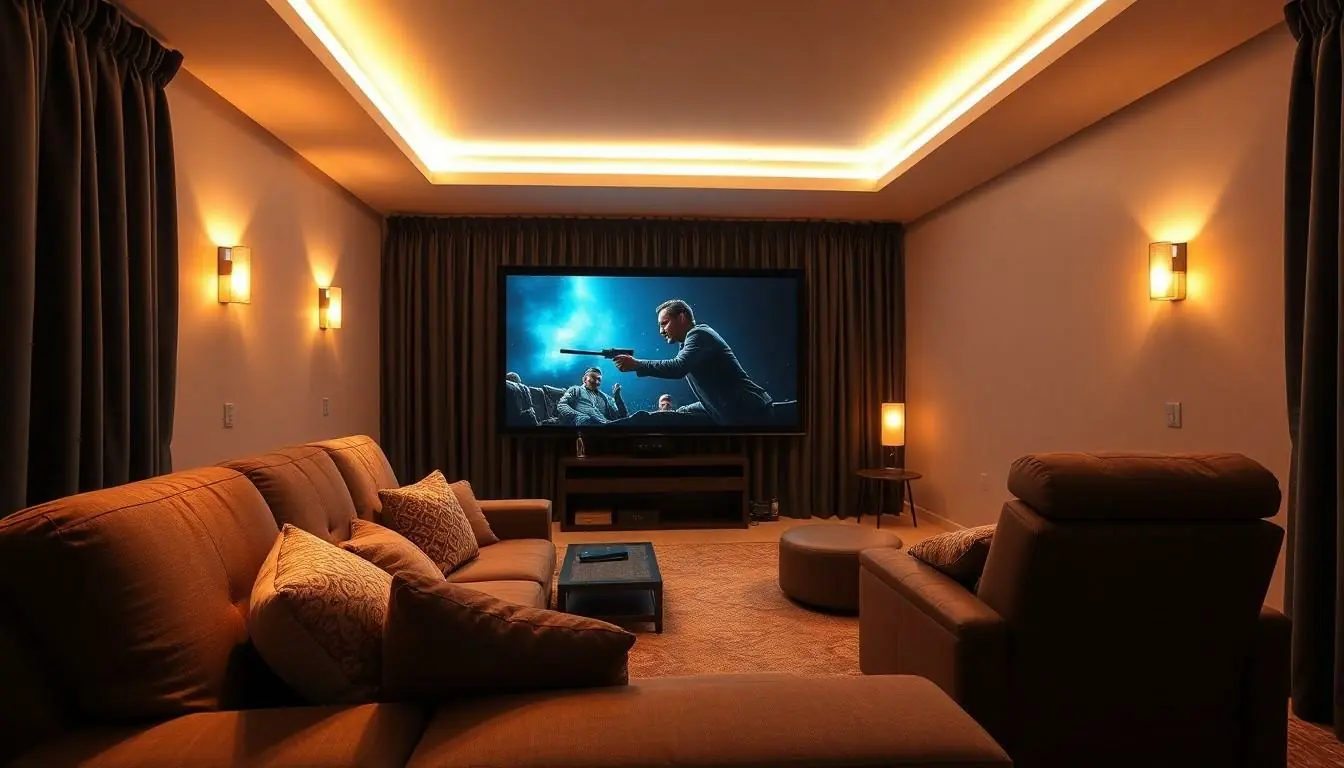Imagine sinking into your plush recliner, popcorn in hand, ready for a cinematic adventure right in your living room. But wait—what’s that? Harsh overhead lights flickering like a disco party gone wrong? Home movie theater lighting can make or break the experience, transforming a simple film night into an immersive escape.
Table of Contents
ToggleUnderstanding Home Movie Theater Lighting
Home movie theater lighting enhances the overall viewing experience. It’s crucial to achieve the right balance, ensuring a comfortable ambiance without distractions.
Importance of Proper Lighting
Proper lighting significantly impacts movie enjoyment. It creates an immersive atmosphere, allowing viewers to focus on the film. Dim lighting reduces glare on screens, enhancing picture quality. A well-planned lighting setup can prevent eye strain and fatigue during long viewing sessions. Customizable options enable users to adjust brightness levels according to their preferences. Overall, thoughtful lighting transforms a simple movie night into a captivating experience.
Different Types of Lighting Solutions
Various lighting solutions exist to suit diverse home theater needs. Ambient lighting provides general illumination throughout the space. Task lighting focuses on specific areas, allowing for activities like reading menus or adjusting seating. Accent lighting highlights features, such as artwork or screens, adding depth to the environment. LED strip lights offer flexibility and energy efficiency, perfect for creative setups. Wall sconces deliver discreet elegance and enhance atmosphere, contributing to an inviting vibe. Each option plays a role in creating an effective and enjoyable home movie theater experience.
Key Lighting Techniques

Proper lighting techniques play a critical role in optimizing the home movie theater experience. Different types of lighting enhance ambiance, functionality, and aesthetic appeal.
Ambient Lighting
Ambient lighting serves as the foundation for any home movie theater. It establishes an overall brightness and comfort level while creating a cozy atmosphere. Soft, diffused lighting options, such as dimmable LEDs or wall sconces, help avoid harsh glare on screens. Maintaining flexibility allows viewers to adjust lighting based on preferences and film genre. Effective ambient lighting complements both the decor and the viewing experience.
Task Lighting
Task lighting focuses on areas where specific activities occur. This includes reading scripts or handling remote controls. Strategically placed fixtures aimed at seating areas help to ensure convenience without disrupting the viewing experience. Using floor lamps or installed LED strips allows for gradual illumination that doesn’t draw attention away from the screen. Implementing task lighting makes everything accessible while keeping comfort a priority during movie nights.
Accent Lighting
Accent lighting adds depth and visual interest to home theaters. It highlights architectural features or decorative elements around the room. Small spotlights, backlighting behind screens, or LED strips along shelves can create dramatic effects. Choosing colors that evoke mood helps set the tone for each viewing. These elements emphasis the room’s design while enhancing the overall cinematic experience.
Choosing the Right Fixtures
Selecting the right fixtures plays a crucial role in achieving optimal home movie theater lighting. Consider various options to enhance both functionality and style.
LED vs. Traditional Bulbs
LED bulbs offer significant energy efficiency, lasting up to 25,000 hours. Brightness levels also exceed those of many traditional bulbs, creating an appealing cinematic environment. Heat generation is minimal, which aids in reducing room temperature, thus enhancing comfort during movie nights. Traditional bulbs cost less upfront but fall short on longevity and efficiency. Consider that LED options come in warm color temperatures, ensuring a cozy atmosphere perfect for movie viewing.
Dimmer Switches and Controls
Dimming capabilities allow for greater control over lighting intensity, enhancing the viewing experience. A well-placed dimmer switch offers flexibility in adjusting brightness according to the film’s mood. Smart lighting controls further elevate convenience, enabling remote adjustments or automation based on specific viewing preferences. Easy access to dimming controls provides the ability to shift from bright ambient light to a soothing, darkened setting seamlessly. Prioritizing these controls will enhance comfort and engagement throughout the movie-watching experience.
Tips for Creating the Perfect Atmosphere
Creating an inviting movie-watching experience hinges on thoughtful lighting choices. The right elements enhance comfort and engagement throughout film nights.
Color Temperature Considerations
Selecting the appropriate color temperature for bulbs plays a crucial role. Warm lighting, typically around 2700K to 3000K, adds a cozy ambiance, making it perfect for relaxed viewing. Cooler tones, closer to 5000K, can feel stark and harsh, detracting from the experience. For optimal results, utilize dimmable LED bulbs that adjust to different scenes. Warmer hues help create a more immersive atmosphere while cooling down light minimizes distractions during action-packed segments.
Layering Light for Depth
Incorporating multiple light sources creates visual interest and depth. Ambient lighting establishes the overall brightness, while task lighting serves specific areas without disrupting immersion. Accent lighting highlights architectural features, contributing to a cinematic feel. Utilize wall sconces or LED strips for layering, as both choices enhance the overall aesthetic. Each layer combines to produce a balanced, engaging environment for viewers. Consider adjusting intensities to match the film’s mood, allowing for fluid transitions throughout the viewing experience.
Avoiding Common Mistakes
Creating the right lighting for a home movie theater requires attention to detail. Several common mistakes can undermine the intended ambiance and disrupt the viewing experience.
Over-lighting the Space
Over-lighting can detract from the immersive nature of a film. Bright overhead lights create glare that distracts viewers and diminishes focus on the screen. Striking a balance involves using soft, ambient lighting rather than harsh, direct lights. Dimming options allow for controlling the brightness to suit different scenes. Utilizing LED light strips or wall sconces effectively avoids overwhelming brightness. Multiple light sources rather than a single fixture can help diffuse illumination. This approach creates an enjoyable atmosphere while enhancing the viewing experience.
Neglecting Light Placement
Neglecting light placement can diminish the effectiveness of an otherwise well-planned setup. Lighting fixtures positioned too close to the screen cause glare and reflections, disrupting visibility. Proper positioning contributes to achieving the ideal vertical and horizontal balance of light. Task lighting should focus on specific areas, such as seating, to enhance functionality without introducing distractions. Accent lights can highlight art or decor without interfering with screen visibility. Considering the placement of each light source creates a more cohesive design and preserves the movie-watching experience.
Creating the perfect home movie theater lighting is essential for an immersive viewing experience. By thoughtfully selecting and layering different types of lighting, one can significantly enhance comfort and engagement. The right fixtures and controls allow for flexibility in adjusting brightness and atmosphere, ensuring that every film night feels special.
Avoiding common pitfalls such as over-lighting and improper placement can make all the difference. With a focus on warmth and visual depth, the home theater can transform into a captivating space that elevates every movie. Embracing these lighting strategies not only improves the cinematic experience but also adds a touch of sophistication to the home environment.




